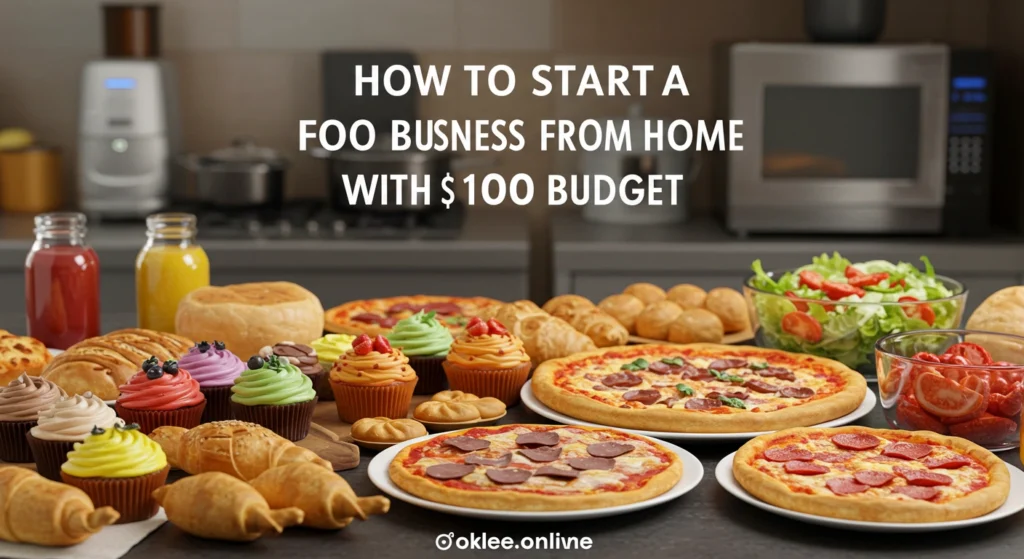Starting a food business from home is one of the easiest and most affordable ways to become your own boss. With the right planning, you can turn your kitchen into a profitable business—without needing a restaurant, big loan, or team of staff.
In this guide, we’ll show you how to start a food business from home with just $1,000 or less. We’ll also cover smart small business financing tips, so you can stay on budget and scale up without unnecessary debt.
1. Choose the Right Food Business Model
Before spending any money, pick a clear focus. The goal is to start small, test your idea, and only expand when you’re ready. Here are a few food business ideas that work well from home:
- Home baking (cookies, cakes, bread)
- Catering small events or meal prep delivery
- Selling sauces, dips, or snacks
- Cultural or ethnic dishes with niche demand
- Healthy meal boxes (keto, vegan, low-carb)
Choose something you already know how to make—and something people around you are already buying. You don’t need a trendy idea, just a great product that solves a simple need: tasty, convenient food.
2. Understand the Legal Requirements
Running a food business from home doesn’t mean you can skip legal steps. Requirements vary depending on your country or state, but here are the basics:
- Register your business name
- Apply for a food handler’s license
- Check local home kitchen laws
- Label your products properly
- Follow safe food storage and hygiene practices
Most local governments offer affordable programs to help small food businesses get started legally. Spend a bit of your budget (around $100–$200) to get compliant—it builds trust and helps you grow later.
3. Budget Breakdown: Starting with $1,000
Here’s a sample budget to help you stay on track:
| Item | Estimated Cost |
|---|---|
| Basic cooking equipment/tools | $200 |
| Ingredients for initial orders | $150 |
| Packaging + labeling | $100 |
| Business license & permits | $150 |
| Marketing (branding/photos) | $100 |
| Delivery containers or fuel | $100 |
| Miscellaneous buffer | $100 |
| Total | $900 |
This budget leaves you with a $100 buffer for emergency costs or to reinvest in your first big order.
Tip: Use what you already have. If you own an oven, pans, blender, etc., your upfront costs will drop even lower.
4. Finance Smart: Spend Less, Earn More
Even with $1,000, your biggest challenge will be managing cash flow. Here’s how to stretch every dollar:
Use Pre-Orders
Instead of guessing how much to make, collect pre-orders through Facebook, Instagram, or WhatsApp. This helps reduce food waste and guarantees income before spending.
Start with Weekly Batches
Make food once or twice a week in small batches. This lets you stay focused, avoid burnout, and learn what sells best.
Track Every Expense
Use free tools like Google Sheets or Wave Accounting to monitor income, costs, and profit. It helps you spot where you’re losing money and where to reinvest.
Reinvest First Profits
Don’t rush to scale. Reinvest your first profits into better ingredients, branding, or packaging. Growing slow but steady is better than going into debt.
5. Set Prices That Make Profit
A common mistake in home food businesses is undercharging. To build a sustainable business, your price must cover:
- Ingredients
- Packaging
- Time/labor
- Utilities (gas, water, electricity)
- Delivery costs
- Business costs (licenses, tools)
Simple pricing formula:
Total cost per item × 2.5 = Selling Price
So if it costs $2.00 to make a meal box, you should sell it for at least $5.00 to $6.00 to earn a fair margin.
6. Build a Simple but Strong Brand
You don’t need expensive branding—just consistency and clarity.
Here’s what you need:
- A name that’s easy to say and remember
- A simple logo (use Canva or hire a $10 freelancer)
- Clean, readable labels
- Social media pages (Facebook & Instagram are enough)
- Great food photos (use natural light, clean backgrounds)
Customers buy based on how your product looks and what story it tells. Tell your story honestly—why you started, who it’s for, and what makes it different.
7. Market with Zero Budget
You don’t need ads to start selling. Focus on organic marketing:
- Post photos of your food on Facebook groups and local marketplaces
- Offer free samples to friends or neighbors in exchange for feedback or shares
- Ask happy customers to tag you in their stories
- Run small giveaways to build attention
- Join community events or farmer’s markets to showcase your product
Consistency matters more than perfection. Posting 3–4 times a week builds visibility and trust.
8. Manage and Grow with Discipline
If you want to scale from $1,000 to a profitable monthly income, you need to treat your food business like a real business:
- Set sales goals
- Track weekly profits
- Don’t mix personal and business money
- Deliver on time, every time
- Always ask for feedback
When you’re ready to grow, consider these options:
- Rent a small shared kitchen
- Hire a delivery helper or assistant
- Apply for a small business financing program
- Offer monthly meal plans or subscriptions
9. Small Business Financing Tips
Even if you start with your own money, you might later need capital to grow. Here are safe financing ideas:
- Microloans from local banks or organizations
- Crowdfunding platforms like Kickstarter
- Peer-to-peer lending (e.g., Kiva)
- Grants for women, youth, or minority entrepreneurs
- Business line of credit (once you have steady sales)
Avoid high-interest personal loans or credit card debt in the beginning. Your goal is profit, not pressure.
Final Thoughts
Starting a food business from home with just $1,000 is not only possible—it’s smart. You get to test your ideas, control your costs, and build something that grows with you. It takes patience, good budgeting, and a willingness to learn, but the rewards are worth it.
With smart small business financing and strong discipline, your home kitchen could be the first step toward long-term financial freedom.
For more about How to Start a Food Business




